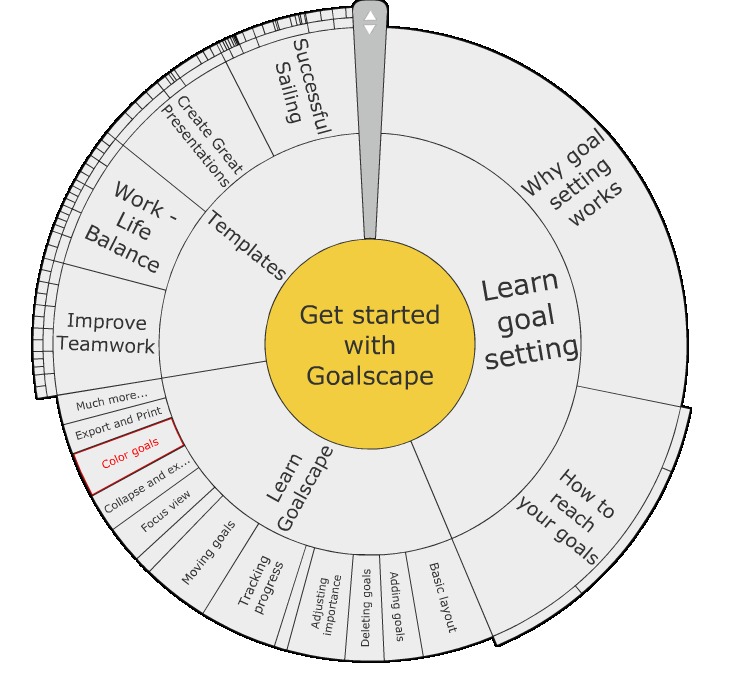While the Mandala Chart is a multi-level rectangular matrix framework, it is also possible to create Mandala in a circular format.

If you search google images with the keyword Mandala, you will find many circular Mandala with intricate abstract geometric patterns, or embedded with Buddhist or Hindu symbolism. While these are engaging to look at, and some produce a calming effect like a visual mantra, for the most part they are more mystical than practical.
Now there is a way to diagram your goals and projects in a circular Mandala format using an innovative software called Goalscape. Instead of surrounding frames, Goalscape gives you concentric circles that form a flexible lens, allowing you to view your selected theme at a distance or up close, at whatever level of detail you choose. The Goalscape intro video gives a good overview to the look and feel of the software, which is so intuitive and simple that you do not need any training manual to get started.
Goalscape: A new way of looking at your projects
The essential premise of Goalscape is that resources in life are limited, so to get best results you need to focus on the big picture. There is a place for detail in the notes panel, but the most effective way to structure our goals is to combine the ability to see the whole picture and be able to zoom down to the details. An integral and unique feature of Goalscape is that each concentric circle is divided into pie slices that can be individually adjusted in size by dragging the corner of the slice. The pie slices can also be dragged and dropped into a new position as you sort and arrange the pieces.
There are controls in the notes panel which allow you to adjust both the size of the slice, and your degree of progress toward completion, as well as add notes and attachments. As you progress on the pieces of your project, the slices fill in with a light grey shading, and converge toward the center with a compelling visual picture of your progress. The software enables you to easily readjust the size and importance, or combination of the parts in relation to the whole.
It is also possible to share your Goalscapes in presentation mode, or export them as a PDF report, PNG image, and in other formats that can be opened by people who do not have the Goalscape software installed.
Integrate with eight
In the Mandala Chart, the basic framework is eight frames around a central theme, which can be expanded to a 64-frame Mandala, and in principle you can drill down as deep as you like. However, once you go deeper than the 64-frame level, your conscious awareness returns to the eight frame view almost by default. There is something in the way our brain processes information that operates optimally when working within limits. The number 8 turned on its side becomes the symbol for infinity ∞, as we see in the Möbius Strip. It is a finite way of grasping the infinite. Without a framework, we face a world that borders on chaos or randomness. In this series we have compared the Mandala Chart to a life compass with 8 points. One way or another, we integrate with eight.
In the Goalscape software it is possible to add more than eight slices, and you can make the pie as complex as you like with subgoals and neighboring goals. However, the more you add to your plate, the more you diffuse your focus, and you soon lose the plot. The software forces you to make choices and focus on what is really important to you. You can start by dividing the first ring of goals into the eight areas of life: Health, Business, Finance, Home, Society, Personal, Learning, and Leisure. Depending on your goals and stage in life, you may want to give more focus to one area or another, and the resulting picture will give you a visual picture of your life in flexible focus.
Dropping out of the Rat Race
We have been conditioned to think of projects as things that we can manage. The typical way to manage a project is on a calendar or on a Gantt Chart. The presumption is that we are running a race in which the players race against the clock (calendar), and pass the baton at predetermined points along the way. It isn’t that the Gantt Chart doesn’t work, but that it works too well at marshaling us into a pattern of racing against the clock, without having a clear bird’s of view of exactly why we are running the race. And as Lily Tomlin said, “the winner of the rat race is still a rat.”
The problem is not with setting goals, deadlines, or landmarks, but rather with tunnel vision that makes us lose sight of the whole and the why. If you feel pressured by your goals and projects, it makes sense to revisit them through a framework of flexible focus. Frameworks such as the Mandala Chart and Goalscape provide an alternative view that is both innovative and ancient, timely and timeless.
In summary, explore the geometry of the Mandala with Goalscape, integrate with eight, drop out of the rat race with flexible focus, ring out the old and ring in the new!


